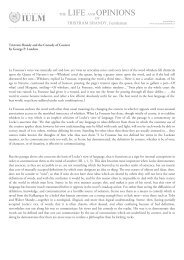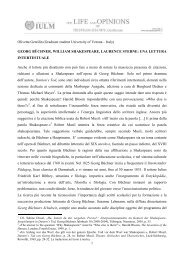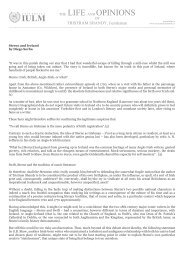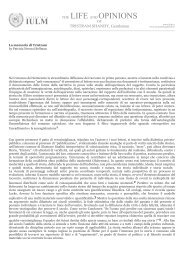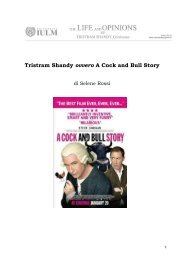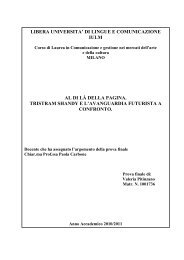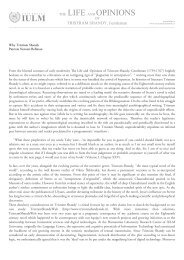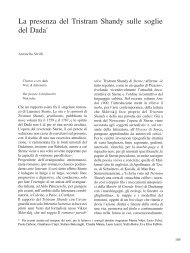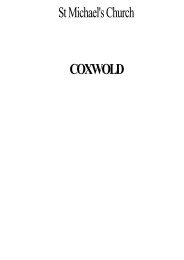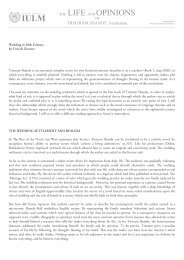download in pdf - The Tristram Shandy Web
download in pdf - The Tristram Shandy Web
download in pdf - The Tristram Shandy Web
Create successful ePaper yourself
Turn your PDF publications into a flip-book with our unique Google optimized e-Paper software.
Biography<br />
by Diego Sorba<br />
INTRODUCTORY NOTES<br />
Nearly all our <strong>in</strong>formation about the first forty-six years of Sterne's life before he became famous as the author of <strong>Tristram</strong><br />
<strong>Shandy</strong> is derived from a short memoir jotted down by himself for the use of his daughter. �is memoir gives noth<strong>in</strong>g but the<br />
barest facts, except<strong>in</strong>g three anecdotes about his <strong>in</strong>fancy, his school days and his marriage. Conversely, for the last eight years<br />
of his life, after the sudden leap out of obscurity caused by his literary success, we have a faithful record of Sterne's feel<strong>in</strong>gs and<br />
movements <strong>in</strong> letters to various persons (published <strong>in</strong> 1775 by his daughter, Lydia Sterne de Medalle) and <strong>in</strong> the 1766-1767<br />
Letters from Yorick to Eliza (also published <strong>in</strong> 1775) 1 .<br />
BIOGRAPHY<br />
www.iulm.it<br />
www.tristramshandyweb.it<br />
Laurence Sterne was the great-grandson of Richard Sterne, Archbishop of York and Master of Jesus College, Cambridge.<br />
Laurence's father, Roger Sterne, was a Yorkshire soldier who served as an officer <strong>in</strong> Flanders under the Duke of Marlborough<br />
dur<strong>in</strong>g the War of the Spanish Succession (1701-1714). His mother, Agnes, the widow of another English army officer,<br />
married Roger Sterne while he was on campaign <strong>in</strong> Dunkirk <strong>in</strong> 1711.<br />
Laurence was born on 24 November 1713 at Clonmel, Co. Tipperary (Ireland), where his father's regiment was stationed.<br />
Sterne spent his early childhood follow<strong>in</strong>g the regiment's many transfers both <strong>in</strong> Ireland and England, and this close contact<br />
with military life would later <strong>in</strong>spire him for the creation of some of his most notable comic characters (especially Uncle Toby,<br />
Corporal Trim and Lieutenant Le Fever <strong>in</strong> <strong>Tristram</strong> <strong>Shandy</strong>).<br />
In 1723, after ten years of wander<strong>in</strong>g (Dubl<strong>in</strong>, Devonshire, Isle of Wight, County Wicklow, Mull<strong>in</strong>gar), Laurence was handed<br />
over to a relation <strong>in</strong> Elv<strong>in</strong>gton (Yorkshire), and sent to a grammar-school at Hipperholme, near Halifax, where he learned<br />
Lat<strong>in</strong> and Greek 2 . In 1727, Sterne's father was seriously wounded <strong>in</strong> a duel. He never fully recovered from the wound and<br />
died suddenly <strong>in</strong> March 1731 .<br />
In July 1733, Sterne was admitted at Jesus College, Cambridge, where his great-grandfather (the Archbishop) had been<br />
master. He took his B.A. degree <strong>in</strong> 1736 and proceeded M.A. <strong>in</strong> 1740. In his last year, a haemorrhage of the lungs was the first<br />
sign of the consumption that was to trouble him for the rest of his life.<br />
Meanwhile, young Sterne had took orders, and <strong>in</strong> 1738, through his uncle's <strong>in</strong>fluence (Jaques Sterne was choirmaster and<br />
canon of York), obta<strong>in</strong>ed the liv<strong>in</strong>g of Sutton-on-the-Forest, about eight miles north of York.<br />
In 1741 Sterne married Elizabeth Lumley, a cous<strong>in</strong> to Elizabeth Montagu, the bluestock<strong>in</strong>g, and <strong>in</strong> 1747 their daughter,<br />
Lydia, was born. Liv<strong>in</strong>g the life of a rural parson, Sterne kept his residence at Sutton for about two generally uneventful<br />
decades. Dur<strong>in</strong>g these years he kept up a close friendship which had begun at Cambridge with a distant cous<strong>in</strong> from<br />
Yorkshire, John Hall-Stevenson (1718-1785), a witty and accomplished epicurean, owner of Skelton Hall (also known as<br />
“Crazy Castle”), <strong>in</strong> the Cleveland district of Yorkshire.
Skelton Hall is nearly forty miles from Sutton, but Sterne, <strong>in</strong> spite of his double duties (he was also vicar of the neighbour<strong>in</strong>g<br />
liv<strong>in</strong>g of Still<strong>in</strong>gton and prebendary, or canon, of York M<strong>in</strong>ster), seems to have been a frequent visitor there, and to have<br />
found <strong>in</strong> his rather eccentric friend a highly congenial companion. Sterne is thought to have never formally become a member<br />
of the circle of merry squires and clerics at Skelton known as “<strong>The</strong> Demoniacks”, but certa<strong>in</strong>ly he must have shared their<br />
revelries on and off 3 .<br />
In 1747 Sterne published a sermon preached <strong>in</strong> York under the title of <strong>The</strong> Case of Elijah. This was followed <strong>in</strong> 1750 by <strong>The</strong><br />
Abuses of Conscience, afterwards <strong>in</strong>serted <strong>in</strong> Vol. II of <strong>Tristram</strong> <strong>Shandy</strong>. In 1759 he wrote a sketch on a quarrel between his<br />
Dean and a York lawyer, a sort of Swiftian satire of dignitaries of the spiritual courts which gave an earnest of Sterne's powers<br />
as a humorist. At the demands of embarrassed churchmen, however, the book was burned: thus, if on one hand Sterne lost his<br />
chances for clerical advancement, on the other he ended up discover<strong>in</strong>g his real talents 4 .<br />
Sterne's marriage, which had never been truly happy, reached a crisis <strong>in</strong> 1758, when his wife, after learn<strong>in</strong>g of an affair with a<br />
maid-servant, had a nervous breakdown and was eventually placed under the care of a doctor <strong>in</strong> a private house <strong>in</strong> York. As<br />
Sterne's own health cont<strong>in</strong>ued to fail, he progressively fell <strong>in</strong>to a state of melancholy: it was <strong>in</strong> this atmosphere of gloom and<br />
despondency that <strong>The</strong> Life and Op<strong>in</strong>ions of <strong>Tristram</strong> <strong>Shandy</strong>, Gentleman, one of the most light-hearted books <strong>in</strong> the whole<br />
of literature, was begun. Sterne completed fourteen chapters <strong>in</strong> six weeks and promised to write two volumes a year for the rest<br />
of his life. A first, sharply satiric version of the novel was <strong>in</strong>itially rejected by the London pr<strong>in</strong>ter Robert Dodsley. Sterne<br />
cont<strong>in</strong>ued his comic novel, but every sentence, he said, was “written under the greatest heav<strong>in</strong>ess of heart”. In this mood, he<br />
decided to soften the satire and describe <strong>Tristram</strong>'s op<strong>in</strong>ions, his eccentric family, and ill-fated childhood with a sympathetic<br />
humour, sometimes hilarious, sometimes sweetly melancholic – a comedy skirt<strong>in</strong>g tragedy.<br />
Sterne himself published the first two volumes of <strong>The</strong> Life and Op<strong>in</strong>ions of <strong>Tristram</strong> <strong>Shandy</strong>, Gentleman at York late <strong>in</strong> 1759,<br />
but he sent half of the impr<strong>in</strong>t to Dodsley. By March 1760, when he went to London, <strong>Tristram</strong> <strong>Shandy</strong> was the rage, and<br />
Sterne became <strong>in</strong>stantly famous. <strong>The</strong> news of his presence there soon spread, visitors thronged to his rooms <strong>in</strong> St Alban's<br />
Street, and <strong>in</strong>vitations to fashionable d<strong>in</strong>ners and receptions abounded. <strong>The</strong> witty, naughty “<strong>Tristram</strong> <strong>Shandy</strong>”, or “Parson<br />
Yorick”, as Sterne was called after characters <strong>in</strong> his novel, was the most sought-after man <strong>in</strong> town: London was charmed with<br />
his audacity, wit and graphic unconventional power. However, he was also much criticized: while Dr. Johnson, who did not<br />
appreciate his use of <strong>in</strong>decent allusions, mistakenly declared “Noth<strong>in</strong>g odd will do long”, readers from York were particularly<br />
scandalized at its clergyman's <strong>in</strong>decency, and <strong>in</strong>dignant at his often scurrilous caricatures of well-known local figures, such as<br />
the male midwife Dr. Slop.<br />
When a second edition of the first <strong>in</strong>stalment of <strong>Tristram</strong> was called for <strong>in</strong> three months, two volumes of Sermons by Yorick<br />
were also announced. Although they had little or none of the eccentricity of the history, they proved almost as popular (<strong>in</strong> the<br />
novel, Sterne had portrayed himself <strong>in</strong> the character of Parson Yorick). Lord Fauconberg presented the author of <strong>Tristram</strong><br />
<strong>Shandy</strong> with the perpetual curacy of Coxwold, and <strong>in</strong> the summer of 1760 the Sterne family returned to Yorkshire, where they<br />
moved <strong>in</strong>to a charm<strong>in</strong>g old cottage, renamed “<strong>Shandy</strong> Hall” after Sterne's literary hero 5 .<br />
Sterne wrote two more volumes of <strong>Tristram</strong> <strong>Shandy</strong> and, the follow<strong>in</strong>g Christmas, he returned to London to super<strong>in</strong>tend their<br />
publication. <strong>The</strong>se volumes appeared <strong>in</strong> January 1761, to the same chorus of praise and criticism as the earlier volumes.<br />
Fashionable society welcomed him back and for another three months he was immersed <strong>in</strong> social life. When he returned to<br />
“<strong>Shandy</strong> Hall”, he cont<strong>in</strong>ued to work on <strong>Tristram</strong> <strong>Shandy</strong>, and the fifth and sixth volumes were completed by December<br />
1761. While supervis<strong>in</strong>g the publication of these volumes <strong>in</strong> London, he suffered a severe haemorrhage of the lungs, and a<br />
journey to the south of France was hastily arranged for his health's sake. Obta<strong>in</strong><strong>in</strong>g a year's absence from his post from the<br />
Archbishop of York, he left for Paris <strong>in</strong> January 1762. This and a later trip abroad gave him much material for his later<br />
Sentimental Journey.<br />
Sterne's fame had preceded him to Paris and he was welcomed <strong>in</strong> much the same way as he had been <strong>in</strong> London. His health<br />
temporarily improved, and, <strong>in</strong> May 1762, he sent for his wife, now recovered, and his daughter, who was suffer<strong>in</strong>g from<br />
asthma. In July, follow<strong>in</strong>g a relapse of his health, they left for Toulouse, where they stayed for a year. Sterne spent the year<br />
writ<strong>in</strong>g a seventh volume of <strong>Tristram</strong> <strong>Shandy</strong>, <strong>in</strong>corporat<strong>in</strong>g some of his experiences <strong>in</strong> France <strong>in</strong>to the story. In July 1763, the<br />
family visited the Pyrenees, Aix-en-Provence and Marseilles, and <strong>in</strong> September 1763, they settled <strong>in</strong> Montpellier for the<br />
w<strong>in</strong>ter. In March 1764 Sterne resolved to return to England, but his wife did not share his desire to leave and decided to stay<br />
<strong>in</strong> France with Lydia, while she completed her education. Hav<strong>in</strong>g accepted his wife's wish, Sterne spent most of the summer <strong>in</strong><br />
London, and then returned to <strong>Shandy</strong> Hall <strong>in</strong> the autumn, where he soon immersed himself <strong>in</strong> an eighth volume of <strong>Tristram</strong>
<strong>Shandy</strong>. <strong>The</strong> seventh and eighth volumes were published on 26th January 1765.<br />
In October 1765, Sterne set out for a seven months' tour through France and Italy, which was later immortalised <strong>in</strong> his second<br />
novel, A Sentimental Journey through France and Italy, by Mr.Yorick. He passed through Paris and Lyons to Tur<strong>in</strong>, where he<br />
began his tour through Italy <strong>in</strong> the company of Sir James Macdonald, a cultivated young man then resident <strong>in</strong> Italy. He visited<br />
Milan, Parma, Florence, Rome and Naples, and, on his return through France, he visited his wife and daughter. Elizabeth had<br />
decided that she could manage better without him, and begged to stay abroad for another year. Thus, <strong>in</strong> June 1766 Sterne<br />
returned alone to Yorkshire for the second time, where his ma<strong>in</strong> companion, now that he was separated from his family, was<br />
his old friend John Hall-Stevenson. By this time Sterne was seriously short of money, hav<strong>in</strong>g spent most of his literary earn<strong>in</strong>gs<br />
on his foreign tours. Hav<strong>in</strong>g a family abroad to support, he set about repair<strong>in</strong>g his f<strong>in</strong>ancial position, by means of the sales of<br />
the n<strong>in</strong>th and f<strong>in</strong>al volume of <strong>Tristram</strong> <strong>Shandy</strong> (completed <strong>in</strong> the autumn).<br />
In December 1766, Sterne was <strong>in</strong> London aga<strong>in</strong>, where he met Mrs. Eliza Draper, the wife of Daniel Draper, an official of the<br />
East India Company, and fell <strong>in</strong> love with her. <strong>The</strong>y carried on an open, sentimental flirtation, but Eliza was under a promise<br />
to return to her husband <strong>in</strong> Bombay. Sterne never saw her aga<strong>in</strong>, but he was not will<strong>in</strong>g to let the relationship go. He sent her<br />
his books, and, hav<strong>in</strong>g had her portrait pa<strong>in</strong>ted, wore it round his neck. With half an eye on posterity, he kept a "Journal to<br />
Eliza", modelled on Swift's Journal to Stella, and also A Sentimental Journey is full of references to Eliza, to the portrait, and<br />
his vows of eternal fidelity to her.<br />
On return<strong>in</strong>g to Yorkshire, he was visited by his wife and daughter <strong>in</strong> August 1767, but, s<strong>in</strong>ce they cont<strong>in</strong>ued to f<strong>in</strong>d each<br />
other's company <strong>in</strong>supportable, he and his wife f<strong>in</strong>ally came to an agreement that she and Lydia should return to the South of<br />
France, with an improved f<strong>in</strong>ancial allowance, and never return to England. Sterne seems to have been content with this<br />
arrangement, although he also seems to have been upset at be<strong>in</strong>g parted from his daughter, for whom he had a genu<strong>in</strong>e<br />
affection. By December 1767, two volumes of A Sentimental Journey Through France and Italy, by Mr. Yorick, were<br />
completed, and Sterne set off with John Hall-Stevenson for London to super<strong>in</strong>tend their publication early <strong>in</strong> 1768.<br />
In March, he fell ill with <strong>in</strong>fluenza, and on the 18th he died.<br />
Legend has it that soon after burial at London, Sterne 's body was stolen by grave robbers and sold for the purpose of<br />
dissection to the professor of anatomy at Cambridge. Luckily, his features were recognised by a student at the dissect<strong>in</strong>g table,<br />
and the body was quietly returned to the grave 6 .
Notes<br />
1 �e holograph manuscript of Sterne's memoir – Sterne's Memoirs:<br />
A Hitherto Unrecorded Holograph Now Brought to Light <strong>in</strong> Facsimile, with <strong>in</strong>troduction and commentary by Kenneth<br />
Monkman (Coxwold, privately pr<strong>in</strong>ted for �e Laurence Sterne Trust, 1985) – is now on permanent loan to “<strong>Shandy</strong> Hall”,<br />
Coxwold. A detailed biography (TRAILL, H. D., “Sterne”, English Men of Letters Series, 1882) is available onl<strong>in</strong>e:<br />
. A more recent and equally thorough source of reference is: ROSS, Ian<br />
Campbell, Laurence Sterne: A Life (Oxford: OUP, 2001). For a selection of Sterne's correspondence: CURTIS, Lewis Perry,<br />
ed., Letters of Laurence Sterne (Oxford: Clarendon Press, 1935, 1967²).<br />
2 “When we read over the siege of Troy, which lasted ten years and eight months, -- though with such a tra<strong>in</strong> of artillery as we<br />
had at Namur, the town might have been carried <strong>in</strong> a week -- was I not as much concerned for the destruction of the Greeks<br />
and Trojans as any boy of the whole school? Had I not three strokes of a ferula given me, two on my right hand and one on<br />
my left, for call<strong>in</strong>g Helena a bitch for it? Did any one of you shed more tears for Hector? And when k<strong>in</strong>g Priam came to the<br />
camp to beg his body, and returned weep<strong>in</strong>g back to Troy without it, -- you know, brother, I could not eat my d<strong>in</strong>ner”<br />
(<strong>Tristram</strong> <strong>Shandy</strong>, Vol. VI, Ch. XXXII).<br />
3 John Hall-Stevenson's various occasional sallies <strong>in</strong> verse and prose - his Fables for Grown Gentlemen (1761 - 1770), Crazy<br />
Tales (1762) and Makarony Fables (1767), which were all ma<strong>in</strong>ly political sketches aga<strong>in</strong>st the opponents of John Wilkes, the<br />
parliamentary reformer - were collected after his death, and it is impossible to read them without be<strong>in</strong>g struck with their close<br />
family resemblance <strong>in</strong> spirit and turn of thought to Sterne's work, <strong>in</strong>ferior as they are <strong>in</strong> literary genius. Hall-Stevenson was<br />
also said to be the orig<strong>in</strong>al of Eugenius <strong>in</strong> Tristam <strong>Shandy</strong>. For a commentary on Hall-Stevenson's Crazy Tales, see<br />
.<br />
4 �e sketch would not be published until 1769, the year after Sterne's death, when it appeared under the title A Political<br />
Romance (and later �e History of a Good Warm Watch-Coat).<br />
5 “<strong>Shandy</strong> Hall” is now a museum.<br />
6 �e story, only whispered at the time, was confirmed <strong>in</strong> 1969: Sterne 's rema<strong>in</strong>s were exhumed and now rest <strong>in</strong> the<br />
churchyard at Coxwold, close to <strong>Shandy</strong> Hall.
CHRONOLOGY<br />
1713<br />
1723 sent to grammar-school <strong>in</strong> Halifax, Yorkshire<br />
1733 admitted at Jesus College, Cambridge<br />
1736 BA, Jesus College, Cambridge<br />
1738 takes orders and obta<strong>in</strong>s the liv<strong>in</strong>g of Sutton-<strong>in</strong>-the-Forest, Yorkshire<br />
1740 MA, Jesus College, Cambridge; contracts tubercolosis<br />
1741 marries Elizabeth Lumley<br />
1747 daughter Lydia born; publishes sermon entitled �e Case of Elijah<br />
1750 publishes sermon �e Abuses of Conscience<br />
1758 marriage crisis<br />
born <strong>in</strong> Clonmel, Co. Tipperary, Ireland<br />
1759 writes his first satirical sketch (published posthumously <strong>in</strong> 1769 under the title A Political Romance,<br />
later History of a Warm Watch-Coat)<br />
1760 <strong>Tristram</strong> <strong>Shandy</strong> (Vols. I-II) published <strong>in</strong> London and York; moves to “<strong>Shandy</strong> Hall”, Coxwold, Yorkshire<br />
1761 <strong>Tristram</strong> <strong>Shandy</strong> (Vols. III-IV) published <strong>in</strong> London<br />
1762 <strong>Tristram</strong> <strong>Shandy</strong> (Vols. V-VI) published <strong>in</strong> London<br />
1762-1764 moves to France (first Paris, then Toulouse and Montpellier)<br />
1765 <strong>Tristram</strong> <strong>Shandy</strong> (Vols. VII-VIII) published <strong>in</strong> London<br />
1765-1766 travels to France and Italy<br />
1766-1767 love-affair with Mrs. Eliza Draper<br />
1767 <strong>Tristram</strong> <strong>Shandy</strong> (Vol. IX) published <strong>in</strong> London<br />
1768 A Sentimental Journey �rough France and Italy, by Mr. Yorick published <strong>in</strong> London soon before his<br />
death (March 18)<br />
1775 daughter Lydia edits and publishes Sterne's Letters and Letters from Yorick to Eliza (written 1766-1767)



